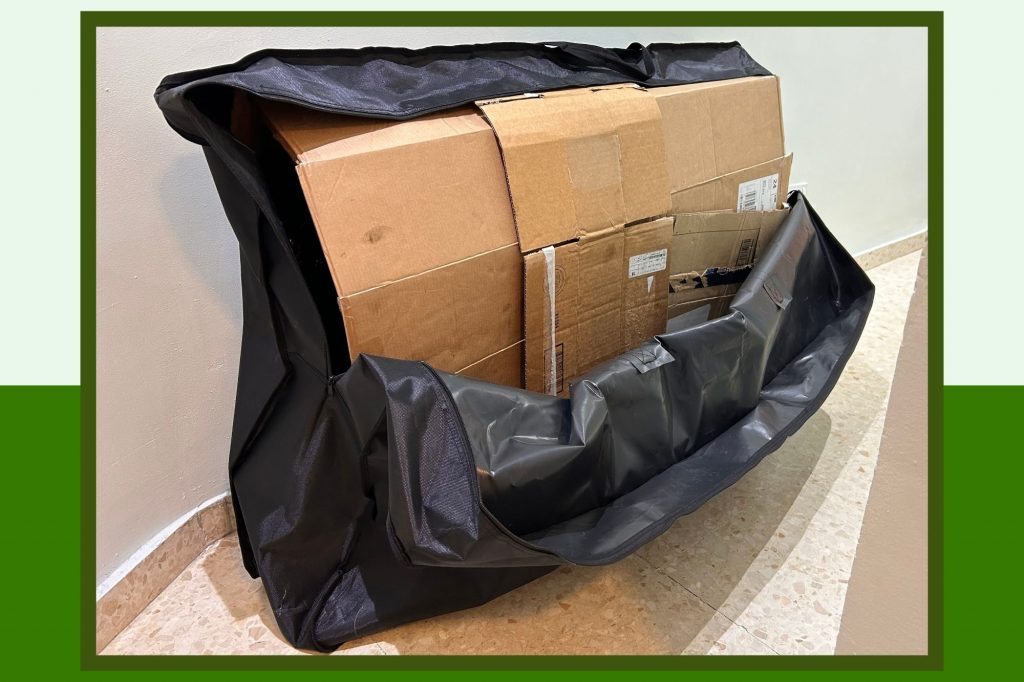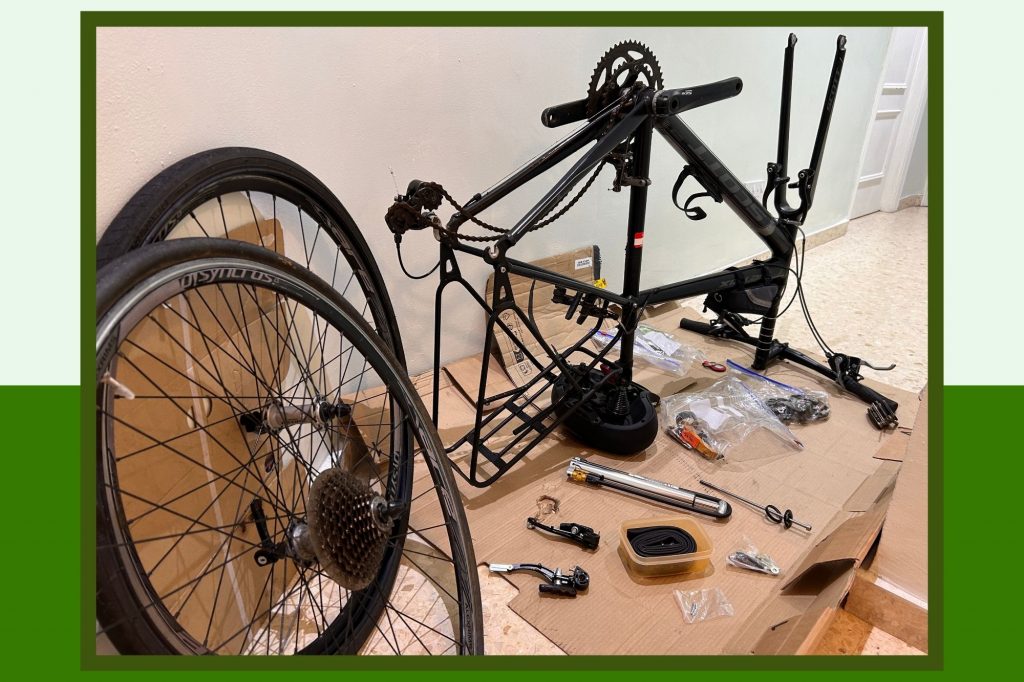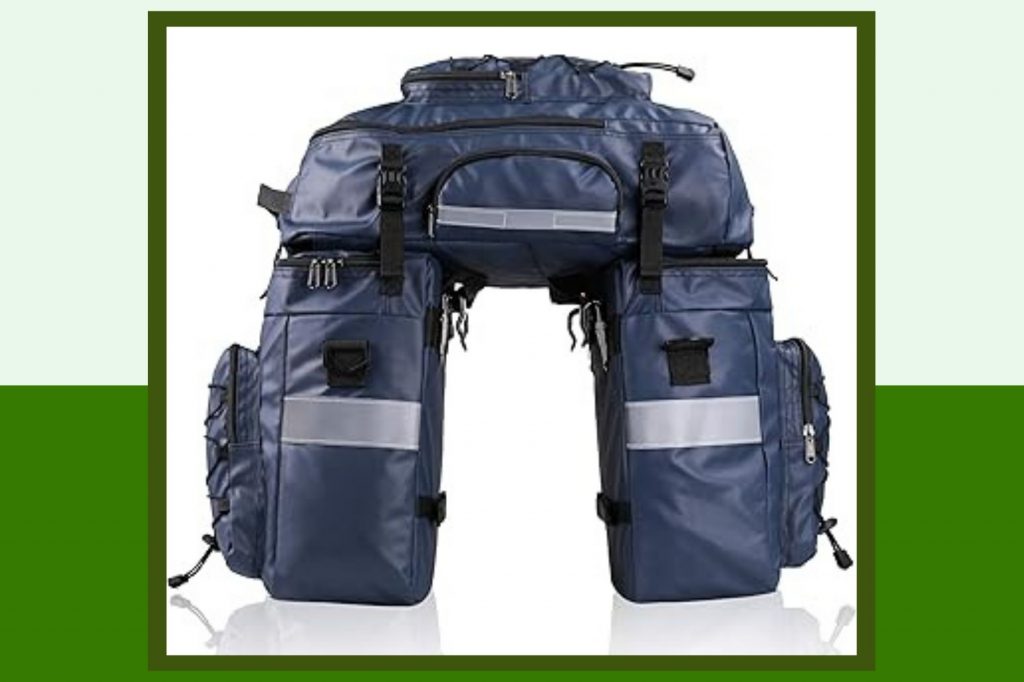How easy is it to take a bike on a plane? Very easy, there’s just a few rules you need to follow. First take the wheels and handlebars off your bike. Second, deflate your tires. And third, pack it all into a bike bag. This is how I did it on British Airways and Iberia Airways.
Going on a long tour also meant I needed specialist bike attachments and equipment to make my ride more comfortable. Filming it was a challenge that also needed specialist equipmen.
Taking Bike Apart
You need to take some parts off your bike before you can put it in a bike bag and take it on a plane. Bike bags come in two main types, hard case or soft case.
Hard cases are best because they offer your bike real protection against the wanton savagery of baggage handlers at the airport who’ve had a bad day. These are perfect for static bike holidays where you stay in the same place and go for day rides. However they’re not so good for cycling from place to place and are more expensive than a soft case.
I used this soft case bag.
It fits within the dimension restrictions of most airlines (usually 190x95x65cm) Yet it is large enough to take my bike when the usual parts are taken off for airline travel. These are:
- Wheels
- Handlebars
- Seat (if you’ve changed it for a comfortable model)
- Pedals
Note that before you put the wheels in the bag, deflate tires because the luggage haul of a plane isn’t pressurized like the cabin.
Also, to protect against the vagaries of those baggage handlers, it’s a good idea to put a layer of protective cardboard around the outside of the bike, particularly to guard the gears.

Photo by Graham Caldow
Bike Equipment: The Key 7
1. Seat.
The first thing I thought about was my seat. Why? Butt ache was a concern to me. Funnily enough, the first thing people asked about when I said I was going on this trip. So I did lots of research on this, and made sure I got a well padded seat.
2. Handlebar extenders.
In the past I’ve suffered from back trouble, and I don’t enjoy the crouched position of road bikes, so I wanted to make my bike more upright. Handle bar extenders come in many heights and are easy to fit.
3. Panniers.
I was genuinely confused about whether budget conscious panniers would be up to the job for cycling the length of Spain, and I didn’t know anyone who could advise me. But I wanted to hear first-hand from a cyclist who uses them rather than someone vested in selling them, i.e. a shop assistant. As chance would have it, I met a touring cyclist from Canada cycling my route one day. She said,
“Just get cheap ones. You’ll be fine with them.”
I didn’t need much persuading, after all we were talking about my money, not someone else’s. The panniers I bought doubled as a backpack – the straps tuck into a sleeve while they’re on the bike so they don’t get caught in the wheel. I used this backpack just about every day because after I arrived at places, I needed to do things like buy water and groceries to take with me for the next day cycling.
4. Bike rack.
Panniers need a rack to attach to. In the past I’ve had a rack for commuting that attaches to the seat stem, but it was flimsy and swung to the side if the screws worked themselves loose as happens with lots of miles. So this time I wanted a rack that attached to the frame of my bike. It was simple to fit and I haven’t needed to adjusted it once so far.
5. Bike spanner, spare innertubes, puncture kit, and tire leavers.
These are a given. While in most cases you may have these already, make sure your bike spanner does have a spanner that fits to take the pedals off.
6. Pump.
Small, lightweight pumps are cheap to buy and seem a perfect solution to pumping up tires after a puncture – all they require is a bit of effort. But most cyclists use foot pumps at home to get their tires to the pressure that’s hard to achieve with a small hand pump.
The pitfall of this? Low tire pressure makes more effort to cycle, and a lot of wasted energy. I knew somewhere along the line I’d get a puncture. I also knew that I’d need to pump my tires up again when I got off the airphane, so I got to research to find the best option.
My helmet looked like this. It’s a mini foot pump and a good compromise. It’s light enough and small enough to fit in panniers easily and has a screw thread to attach to the valve so pump up tires very well. It even has a pressure gauge to show the tire pressure.
7. Helmet.
I wanted a helmet that had a built-in light so I was clearly visible to cars behind. As it happens I think it saved my life when a very alert Spanish driver covered for my mistake as I pulled out in front of him – thankyou whoever you are!
This was the helmet I chose. It has 8 settings, from solid red to various degrees of pulsating light, and I found a solid charge lasted me the better part of two days
Other Equipment
Along the way I wanted to video this ride. From past experience with a GoPro I found the quality extremely good, and when talking to a BBC cameraman who filmed a piece on me before I left as a part of my charity fundraiser, he said:
“I use a GoPro all the time, it’s the second-best thing to this….” He meant his BBC camera.
My model is before this [Example] but all of them are great for outdoor action, light, and waterproof. If I do have one criticism, it has an operating system designed by a kindergarten pupil who’s never used an electronic device before. I only persist using mine because the quality is so, so good.
A GoPro needs a GoPro clamp to fit to the bike. I was lucky, the same BBC cameraman loaned me his to take with me. This is the one [Example]. It has adjustable angles and I used it successfully to clamp to a tree so that I could film certain parts of my ride for local television.
I also took a bike phone clamp with me. This is the one [Example] I used. It is sturdy, and the time my phone fell out of it was due more to the superprotective phone case that I had, which was too bulky for the clamp. But after I changed phone cases, I didn’t have a problem.
Taking Bike On The Plane
There are a few details about taking your bike on a plane that we haven’t mentioned. First you usually need to notify beforehand the airline you want to take your bike on the plane. This often involves an additional cost.
Another thing worth noting, after you’ve checked in, is you’ll usually drop off your bike bag to somewhere else because it won’t go along the usual conveyer belts, so allow yourself a little extra time.
I used the opportunity to do a little maintenance so your bike arrival won’t quite look like this.
Putting Bike Back Together
Once your bike comes out at the destination airport baggage collection point, you’ll need to take your bag and put your bike back together. I arrived a couple of days before I left to give myself time to put my bike together and test ride it.

Photo by Graham Caldow
Final Thoughts
How easy is it to take a bike on a plane? Not difficult! The most important things are to let your airline know, buy a bike bag, and detach some parts of your bike to make it fit into the bag. To find out how I coped with my first day on the road in a strange environment as I set off on my 30 Day ride from Tarifa on the very southern tip of Spain to Bilbao in the north, read Perilous, Astonishing Road Bicycling to the Rock of Gibraltar.
Disclaimer: Just a word to the wise. Some of the links in this post use affiliate links but at no extra cost to you. I’ll earn a commission. When you make a purchase using one of these affiliate links, the company compensates me, which helps me run this blog and keep the content free of charge to you. Thank you for your support 🙏




Pingback: Perilous, Astonishing Road Bicycling to the Rock of Gibraltar | Graham Caldow
Great blog. What brand is the bike bag please?
Hi Sandie
It was a Wildken Pannier Bag, 65l. The link is https://www.amazon.co.uk/dp/B09162JDM8?ref=ppx_yo2ov_dt_b_fed_asin_title&th=1
What I liked about it was the top part came off and I could wear it like a backpack, which came in very useful. I met a Spanish cyclist in the UK and she advised me to not spend too much, and that worked out ok for me.
Pingback: How To Get Fitter Easily When Over 50 Cycling | Graham Caldow